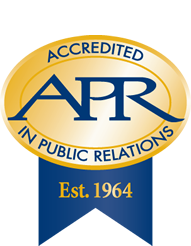Item-Writing for the Examination for Accreditation in Public Relations (APR)
The 2016 Examination for Accreditation in Public Relations rolled out on Jan. 1, and nearly all of the questions that comprise the two versions of the Examination for Accreditation in Public Relations were newly written or  significantly updated from the prior versions.
significantly updated from the prior versions.
Let’s dispel some old myths: Creating new and updating older questions, also called “items,” are not a once-in-every-so-many-years’ event for the UAB. Item-writing is a continuous, intricate, arduous and scientific process, and actually, not all that mysterious.
Let me explain.
The Universal Accreditation Board (UAB) has an open invitation to all public relations practitioners, including those who do not hold the APR credential: If you are interested in helping to promote the profession, you can submit items for the Examination. We’ve even made it quite easy with an online submission tool for item submission. While items historically have been submitted by a relatively small group of usual suspects who appreciate the process and are willing to volunteer, it is not a restricted group. We now appeal to a wider range of industry practitioners, hoping that will lead to more diversity among the types of items written. (Plus, it’s tougher than it sounds, so more writers always are needed.)
All of the items on the Examination are designed to test a candidate’s understanding of the enduring principles of public relations as outlined in the knowledge, skills and abilities (KSAs) and their related learning objectives. Candidates who can answer a predetermined number of questions correctly will have demonstrated their mastery of these principles and will pass the Examination. None of the questions are designed to be tricky, misleading, ambiguous, trivial or irrelevant, and we have many steps in the process to ensure that they are not.
Item-writing follows a fairly simple formula. 1) Choose the KSA for which you wish to write. 2) Select a specific learning objective under that KSA. 3) Develop a question that will test a candidate’s knowledge of the particular KSA/learning objective. 4) Provide the correct answer and at least three distractors (wrong answers). 5) Back it up with at least one academic citation or other reference.
Once you know the objective for which you are writing, develop a question, keeping these points in mind:
- Avoid opinion-based questions that ask, “What would you do …,” or “What would you try…,” as any answer could be correct.
- Avoid asking for the best way of doing something, as that could be overly subjective, unless you are qualifying it by including a particular expert’s documented opinion on what is best. Consider instead asking what is the first thing one should do in a given scenario.
- Avoid the “all of the above” or “none of the above” options.
- Don’t make all of the correct answers the longest.
- Use single construct questions because compound items are harder to analyze statistically and tend to heighten text anxiety. Basically, this means that every question should be asking only about one thing, not multiple things.
- Avoid absolute modifiers like always, never, none, all, every, etc., as they make it easy to eliminate answer options.
- Avoid asking for a negative answer such as “Which of the following would you not do?”
- Less is best. Wordy items take longer for the candidate to read, so get to the point and avoid unnecessary background information.
- Find a balance between being too specific, which can become trivial, and too general, which can become ambiguous.
- Ensure your answer options don’t contain exact wording from the question, as that tends to give away the answer and supports an educated guess.
- Ensure your questions don’t contain exact wording from the preparation materials, as that tends to test recall rather than learning and understanding.
- Use appropriate vocabulary but write to a sixth-grade reading level. (Yes, really.)
- Don’t include teaching lessons or reinforce what a candidate should know. The purpose is to verify candidate’s existing knowledge.
Each item should have three components: the stem, the correct answer and multiple distractors.
The stem should be written in the form of a question, and the qualified candidate should be able to recognize immediately what is being asked and know what the answer is before reading the answer options. The stem should be a brief, complete sentence or short situation description with all of the information needed to determine the correct answer.
The correct answer should always be correct and recognizable by a candidate who is minimally qualified to pass the Examination. There cannot be multiple correct or plausible answers, unless you instruct the candidate to select multiple answers out of the choices given.
The distractors should always be incorrect but plausible enough that a candidate who is not minimally qualified to pass the Examination might not be able to discern the correct from incorrect answers. Distractors that are obviously wrong serve no purpose, as even candidates who are not qualified to pass the Examination will not select them. Although you may be tempted, avoid including humorous distractors that are obviously wrong.
Once you have written your question, you’ll need to provide an academic citation or citation to another resource on our bookshelf. This step is critical, as we not only have an obligation to provide candidates with study resources that contain the information on which they are being tested, but also the references provide validity for the answers. As an item-writer, you should provide the citation for any question that you submit. If you don’t have access to academic textbooks or other reference books, just be aware that if a member of the UAB cannot double-source your question, it likely will be tossed out before being considered.
After a question has been submitted, it will be reviewed by the UAB’s Examination Work Group, and its source will be verified. Eventually, the question will make its way to the technical review process for vetting. The technical review involves a panel of Accredited professionals, referred to as subject-matter experts (SMEs), who convene to review all items, from the way they are worded to whether they match the KSAs and learning objectives. They also verify that there is one clearly correct answer to each item and that the distractors are appropriately distracting. Items may be edited for style, modified to correct confusing language, rewritten on a grand scale or rejected entirely. The goal of this process is to develop sound questions that qualified candidates will answer correctly and that candidates who are not qualified will not be able to answer correctly.
Sample questions are available to help candidates better understand how the questions are framed and presented, and these also can help item-writers get an idea of how their own submissions can be written.
If you are interested in item-writing, follow this link to our online submission tool.
Kathleen M. Giery, APR, CPRC is the chair of the Universal Accreditation Board Examination Work Group. She can be contacted at gieryk@lifequest.ufl.edu.







Nice Post, i like this ,everytime i read on this website found something new
Nice Post, i like this ,everytime i read on this website found something new